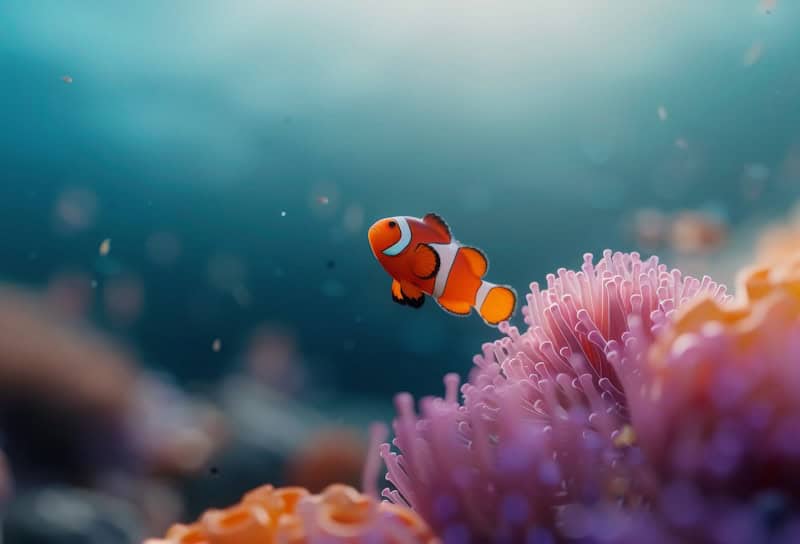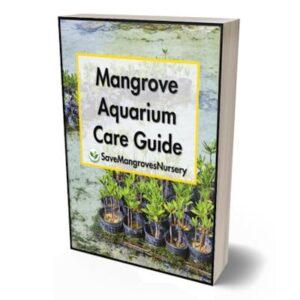
Adding mangroves to a freshwater aquarium can transform the tank into a lush, vibrant environment. Yet, several common pitfalls can turn this noble endeavor into a struggle.
Here’s a journey through the top five mistakes to avoid, ensuring those mangroves not only survive but thrive in their new home.
Mistake #1: Not Providing Enough Light
The Importance of Proper Lighting
Imagine the setting of a red mangrove tree in its natural habitat—sun-drenched coastal shores where it flourishes. In an aquarium, replicating this environment with adequate light is crucial. Insufficient lighting quickly becomes evident as mangrove plants in an aquarium fail to grow or display yellowing leaves.
So how do we find the solution to this situation?
Good vs Bad Lighting Choices
✅ Good: Choose a full-spectrum LED light that simulates natural sunlight, ensuring 10-12 hours of light daily. This setup mimics the sun’s beneficial rays, encouraging robust growth.
❌ Bad: Using low-wattage or non-full-spectrum lights can stunt growth and lead to unhealthy plants. The lack of proper light often results in disappointing outcomes.
Investing in a quality lighting system not only benefits the mangroves but enhances the entire aquarium’s appearance.
Mistake #2: Ignoring Water Quality
Water Quality Matters
Think of water quality as the foundation of a healthy aquarium. Just as a plant needs rich soil, mangroves require clean, stable water conditions. Poor water quality can stealthily damage these plants, leading to issues that might go unnoticed until it’s too late.
Water Quality Pros and Cons
✅ Pros: Regular water changes, using high-quality water conditioners, and monitoring pH levels keep the environment stable and supportive for mangrove health.
❌ Cons: Allowing high levels of nitrates, ammonia, or incorrect pH to persist can lead to poor growth and unhealthy plants. These factors often cause long-term damage if not addressed promptly.
Maintaining clean water is crucial for a thriving tank and contributes to the overall health of all aquatic life within.
🛑 For more insights on keeping mangroves healthy, check out the article on Top Care Tips for Adding Red Mangroves to an Aquarium.
Mistake #3: Planting Mangroves Incorrectly
Correct vs. Incorrect Planting
Consider the excitement of planting mangroves in an aquarium. Proper planting is essential—ensuring that the top of the propagule remains above the substrate allows it to grow healthy roots. Incorrect planting techniques can lead to rotting and poor development.
Good vs Bad Planting Techniques
✅ Good: Positioning the propagule so that the top stays above the substrate allows roots to grow downward. This simple step ensures healthy plant growth.
❌ Bad: Burying the entire propagule in the substrate can lead to rot and impede growth. This mistake often results in plants that struggle to thrive.
Following correct planting techniques sets the stage for a flourishing mangrove environment.
Mistake #4: Overlooking Nutrient Needs
How Do I Feed My Mangrove Plants?
Mangroves are known for their ability to filter water, but they still need proper nutrition to grow. Many enthusiasts find that providing additional nutrients helps boost mangrove health and growth. Relying solely on tank water for nutrients can lead to deficiencies.
Nutrient Management Pros and Cons
✅ Pros: Supplementing with a liquid fertilizer designed for aquatic plants ensures that mangroves receive all the essential nutrients needed for robust growth.
❌ Cons: Neglecting to provide additional nutrients often leads to stunted growth and unhealthy plants. This oversight can have long-term impacts on mangrove vitality.
Regular nutrient supplementation supports healthy mangrove development and contributes to a vibrant aquarium ecosystem.
Mistake #5: Neglecting Patience
Patience Is Key
Growing mangroves requires patience. These plants do not grow rapidly, and immediate results should not be expected. Enthusiasts often find that patience and consistent care are the keys to success. Impatience can lead to unnecessary adjustments, which can stress the plants.
The Pros and Cons of Patience
✅ Pros: Understanding that mangroves need time to establish and grow will result in a more successful and rewarding experience.
❌ Cons: Making frequent changes out of impatience can negatively affect mangrove health. Stressing the plants with constant adjustments often leads to setbacks.
Allowing time for mangroves to adapt and grow ensures a healthy and thriving aquarium.
Why Choose Save Mangroves Nursery?
Save Mangroves Nursery specializes in growing and shipping red mangrove plants suitable for saltwater, freshwater, or brackish tanks. Each plant is carefully nurtured to arrive in excellent condition, ready to enhance any aquarium.
For only first-time new customers interested in experiencing top-quality mangrove plants for your aquarium, a special offer of 5 Free Sample Red Mangrove Plants is available – you only need to cover the shipping cost.
This one-time offer is accessible at the top of the page and is a great opportunity to start with high-quality plants!
Avoiding common mistakes in mangrove care will lead to a flourishing and vibrant aquarium. From proper lighting and water quality to correct planting and nutrient management, each step is crucial for mangrove success.
With the right care and patience, mangroves will enhance the beauty and functionality of the aquarium. Save Mangroves Nursery is here to support every step of the way, ensuring successful mangrove growth.
How Do I Choose My Very First Plant?
So you have learned about the incredible benefits of adding mangrove plants to your tank, but you still don’t know which exact plant to add to your specific tank size?
Don’t worry, because we’ve created an easy Step-by-Step guide to help you with your selection process.
Click the button below to find out which plant is perfect for your aquarium.

 Cart is empty
Cart is empty 
